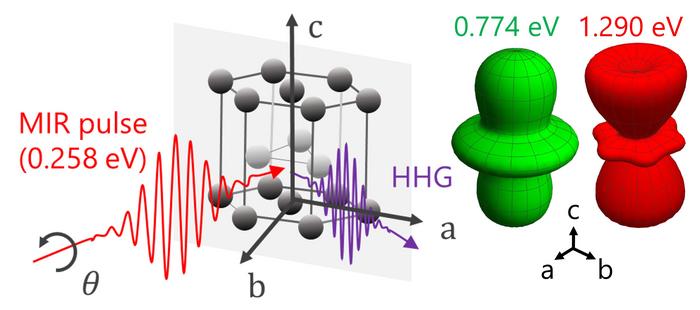A recent breakthrough in understanding the electrical and mechanical properties of titanium has emerged from a comprehensive study conducted by a research team at Yokohama National University. By employing high harmonic generation techniques, the researchers have effectively mapped how the orientation and behavior of electrons in titanium contribute to its unique characteristics. Their innovative approach has significant implications for the development of advanced titanium alloys, which are crucial for various applications in industries such as aerospace, medical technology, and precision manufacturing.
Titanium is renowned for its exceptional qualities, including high strength-to-weight ratio, lightweight nature, and resistance to chemical corrosion. These attributes make it highly sought after in fields such as biomedicine, where its biocompatibility allows for the creation of implants and prosthetics, as well as in the aerospace sector, where materials are required to withstand extreme conditions while maintaining structural integrity. Understanding the properties of titanium at the atomic and electronic levels is therefore critical for enhancing its applicability across these sectors.
The methodology developed by the Yokohama National University team involves the use of high harmonic generation, a process in which intense infrared laser pulses are directed at titanium samples. This technique leads to the emission of light signals at higher frequencies compared to the original laser beam. By analyzing these emitted signals, the researchers can gain insights into the electron dynamics and atomic bonding within the metal. As Professor Ikufumi Katayama, the lead author of the study, explains, these signals are invaluable in investigating how electrons interact with the material and how they are influenced by the atomic structure.
However, high harmonic generation is particularly challenging with metals like titanium. This is because the free electrons that render metals good conductors tend to interact strongly with the laser light, effectively screening it and thereby muddling the resulting signals. As a result, the team meticulously optimized the laser parameters to mitigate this screening effect, allowing for clearer data collection. The researchers were able to observe how changes in the electronic structure occur under varying experimental conditions, revealing fundamental insights into the behavior of titanium.
The study further illuminated the importance of the electron energy bands within titanium. These bands serve as pathways for electron movement, and the researchers found that the orientation of the incoming laser light greatly influenced how electrons behaved as they traversed these bands. It turned out that the unique crystalline structure of titanium complicates this behavior, as it allows electrons to travel differently depending on the crystallographic direction. Consequently, whether a force is applied along a certain axis can dramatically impact the material’s mechanical properties, such as toughness and flexibility.
One of the pivotal findings of the research was the identification of a directional dependence in bond strength within titanium. The emitted light signals showed a decrease when electron transitions occurred between different energy bands, suggesting that the alignment of titanium’s atomic structure plays a foundational role in determining the strength and flexibility of its bonds. This revelation underscores the concept of anisotropy, where the properties of the material vary based on direction. This characteristic has vast implications for alloy design, as engineers can tailor titanium alloys for specific applications by manipulating these directional properties.
In adopting the perspective that the atomic arrangement influences the electron dynamics, the study contributes significantly to the foundation of materials science. Continuous advancements in this area can lead to increasingly sophisticated titanium alloys, specifically engineered for a variety of demanding applications. Innovations in alloy composition and treatment processes can enhance performance, especially for products used in high-stress environments like jet engines and dynamic implants.
The research team demonstrated that the capabilities offered by high harmonic generation extend beyond merely observing electron behavior; they provide a novel way to visualize complex phenomena at the atomic level. The findings also illustrate that even slight alterations in the electron configuration can produce significant variations in the material properties of titanium alloys. This highlights the need for a deeper understanding of material behaviors to inform better engineering practices.
As industries continue to leverage the remarkable properties of titanium, the insights garnered from this research will undoubtedly facilitate the design of stronger, more versatile materials. For example, the aerospace sector stands to benefit immensely from titanium alloys that can withstand greater stress and fatigue while remaining lightweight. Similarly, advancements in medical devices can lead to longer-lasting and more effective implants, improving patient outcomes and shifting paradigms in care.
Ultimately, this study not only enriches our understanding of titanium but also opens the door to future research avenues. Researchers may explore analogous methodologies in other materials to uncover further nuances that dictate material behavior in response to various stimuli. This could lead to revelations in not just metals, but also polymers and composites, all of which rely heavily on atomic and electronic structures for their functionality.
As the industrial landscape evolves, so too will our approaches to materials engineering. Insights like those presented in this research underscore the importance of interdisciplinary techniques in both basic and applied sciences. A synergy between physics, chemistry, and engineering will be paramount in shaping materials for the future, making studies like this one vital to our ongoing quest for innovation.
The research by the Yokohama National University team represents a profound step forward in our comprehension of material science, specifically concerning titanium and its alloys. The applications of these findings will resonate across multiple fields, paving the way for future advancements and improvements in technology and industry, showcasing the boundless potential of academic research to transform our world.
Subject of Research: Titanium’s Mechanical Properties and Electron Behavior
Article Title: Three-dimensional bonding anisotropy of bulk hexagonal metal titanium demonstrated by high harmonic generation
News Publication Date: December 18, 2024
Web References: Nature Communications Physics Article
References: doi:10.1038/s42005-024-01906-0
Image Credits: Yokohama National University
Keywords
High harmonic generation, titanium, anisotropy, electron behavior, materials science.





